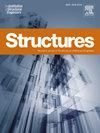预制钢筋混凝土梁柱节点的抗震性能及震后功能恢复
IF 4.3
2区 工程技术
Q1 ENGINEERING, CIVIL
引用次数: 0
摘要
结构可恢复性的概念已经成为结构抗震设计中的一个重要性能目标。本文介绍了一种新型的可替换预制混凝土梁柱复合消能节点,该节点主要由复合消能箱和摩擦侧板组成。共制作了3个试件,进行了低周往复试验,研究了试件的破坏模式、迟滞性能、强度退化和位移延性。结果表明:所有试件均表现出延性破坏模式,主要表现为现浇节点梁端塑性铰的形成,以及预制节点中fsp和复合edb的破坏;预制试件具有较强的位移延性和转动能力。更换复合材料edb后,由于fsp损伤,修复后的试件的峰值承载能力降低了7.75% %。但其位移延性和耗能能力受影响较小,说明新型耗能节点具有较强的抗震性能,有利于震后功能恢复。本文章由计算机程序翻译,如有差异,请以英文原文为准。
Seismic performance and post-earthquake function recovery of prefabricated reinforced concrete (RC) beam-column joints
The concept of structural recoverability has emerged as a crucial performance objective in the seismic design of structures. This paper introduces a novel replaceable prefabricated RC beam-column composite energy dissipation joint, which primarily consists of composite energy-dissipation boxes (EDBs) and friction side plates (FSPs). A total of three specimens were fabricated, and low-cycle reciprocating tests were conducted to investigate their failure modes, hysteresis performance, strength degradation, and displacement ductility. The results indicated that all specimens exhibited ductile failure modes, characterized by the formation of plastic hinges at the beam ends of cast-in-place joints, alongside damage to the FSPs and composite EDBs in the prefabricated joints. The prefabricated specimen demonstrated strong displacement ductility and rotational capacity. Following the replacement of the composite EDBs, the repaired specimen exhibited a 7.75 % reduction in peak bearing capacity due to damage to the FSPs. However, its displacement ductility and energy dissipation capacity were less affected, suggesting that the proposed new energy-dissipating joint possesses robust seismic performance and facilitates functional recovery post-earthquake.
求助全文
通过发布文献求助,成功后即可免费获取论文全文。
去求助
来源期刊

Structures
Engineering-Architecture
CiteScore
5.70
自引率
17.10%
发文量
1187
期刊介绍:
Structures aims to publish internationally-leading research across the full breadth of structural engineering. Papers for Structures are particularly welcome in which high-quality research will benefit from wide readership of academics and practitioners such that not only high citation rates but also tangible industrial-related pathways to impact are achieved.
 求助内容:
求助内容: 应助结果提醒方式:
应助结果提醒方式:


